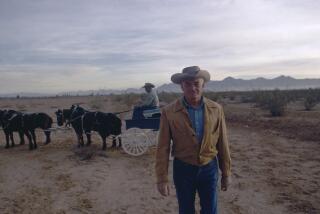Historian a sharpshooter with the facts
Sometimes, Ben Traywick feels like one of those quick-draw gunslingers who once prowled the wood-planked sidewalks of this Old West town. One by one the challengers come, each seeking to test his skills.
No shots are fired because these are factual face-offs aiming to define the true history of the town once home to such dangerous characters as Doc Holliday, Wyatt Earp and Billy Clanton.
For nearly half a century, Traywick was Tombstone’s official historian. He’s written three dozen books, such as “Death’s Doings in Tombstone,” and published 2,400 articles on such diverse topics as the infamous gunfight at the OK Corral and why lawman Wyatt Earp never smiled.
Over the years, the self-taught Traywick has done consulting work for National Geographic, the Discovery Channel and movie producers. He’s been honored by city officials. Still, the wannabes seek their duels — amateur Wild West experts itching to match their stuff against the best. With a sigh, the 85-year-old Traywick, wearing his snakeskin-ringed cowboy hat, patiently hears them out. Then he unloads.
Like the guy who said Traywick didn’t know half as much as he thought he did. The newcomer insisted that Indian Chief Cochise raided Tombstone in 1880. The historian cut him off at the pass: Didn’t happen, Traywick deadpanned. Cochise died in 1874.
“Everybody who comes to Tombstone becomes an instant expert as soon as they hit the nearest bar stool,” Traywick said. “It makes it hard to pursue real history.”
In 2010, Traywick officially retired as town historian, but he can’t quit his history habit. Each day, Traywick sits in his bookstore surrounded by his tomes, news clippings and memorabilia, debating and answering questions from anyone who walks through the door.
Traywick still relishes trading barbs with the actors decked out in western attire who run reenactment groups like the one he started as a tourist attraction. Years back, he played Earp in the ensemble he named “The Wild Bunch,” until, he said, his belly got too big.
Then his son took over for two decades.
“I told him, ‘When you’re playing Wyatt Earp, you never smile, because Wyatt never smiled. He just didn’t have it in him.’”
On a recent day, he teased Terry “Doc” Najarian, who runs a reenactment show, because his cowboys were smoking factory-made cigarettes. The real boys rolled their own, he insisted.
“Ben knows his history,” Najarian said. “When I see him, I’m like a sponge.”
Traywick is an unlikely Wild West chronicler: He grew up in the Cumberland Mountains of Tennessee, a chemist with a background in explosives. He stumbled into Tombstone on a cross-country road trip. For three nights he walked around, avoiding the tourists, marveling at the history around him.
He liked the fact that Tombstone was one tough town in its day. “It wasn’t a place where you pushed people around,” he said. “Nobody here got pushed around.”
Traywick, who lived in California at the time, returned home and told his wife and children to pack their bags. “I just belong down there,” he said. They arrived Thanksgiving Day 1968. He soon landed a job as a safety engineer at a nearby gunpowder plant.
That’s when Traywick began his Tombstone education. He scoured Boothill Graveyard and visited historic spots outside of town — by horse, Jeep or on foot. He examined the archives of longtime local residents to confirm stories that often had numerous versions. He consulted newspaper obits, court records and coroner’s reports — hardscrabble research has never included the Internet.
“Ever think that what you take off the Internet is only as good as the fella who put it there?” he said matter-of-factly.
Traywick believes Tombstone has been done wrong by television. “The movies all have this romantic image of Tombstone as a town of silk and lace and men with clean hands,” he said.
Not only that, but the mule teams and workers who served the area’s thriving silver mines wallowed in mud and excrement. With questionable water sources, residents rarely took baths. “Most people smelled like buffalo,” he said.
Traywick has worked to dispel other myths. Old Tombstone never counted 35,000 residents — including 3,500 prostitutes and 110 saloons — as many claim. At the town’s heyday, 5,300 lived here, and only a few score prostitutes in a handful of bars.
Traywick has compiled a death list: Between 1879 and 1900, about 125 people were killed in the place known as “The Town Too Tough to Die.” Most died from fights that started over whiskey, women, money or politics. Men died in knife fights. They struck each other with rocks. They perished in Indian raids.
Rarely, Traywick says, was anyone bold enough to face off in the streets in a gun duel.
“I call gunfights murder,” he says. “One cowboy would hide in the shadows and call out another’s name and then shoot him the moment they turned around.”
And he says only a few gunslingers were ever hanged; most got off scot-free.
Most of his research centers on the OK Corral fight. In the gun battle — which lasted only 30 seconds with 30 shots fired — lawmen Virgil Earp and his brothers Morgan and Wyatt, aided by Doc Holliday, confronted outlaw cowboys Billy Clanton, Tom McLaury and his brother Frank. The lawmen had finally responded to repeated threats from the gang.
“I have spent my life making sure I knew what happened in that gunfight,” he said. “I took it apart, move by move.”
Four words sealed the battle’s place in Old West history: Tombstone, OK Corral, Earp and Holliday. “Those names were magic,” he said. “Without them, this town would have crumbled up and disappeared in the desert a long time ago.”
More to Read
Start your day right
Sign up for Essential California for news, features and recommendations from the L.A. Times and beyond in your inbox six days a week.
You may occasionally receive promotional content from the Los Angeles Times.






